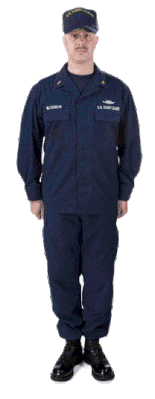United States Coast Guard Police
The United States Coast Guard Police (CGPD) are law enforcement units stationed at certain shore facilities of the United States Coast Guard.
| United States Coast Guard Police | |
|---|---|
 Flag of the U.S. Coast Guard | |
| Abbreviation | CGPD |
| Motto | "Service, Integrity, Justice!" |
| Jurisdictional structure | |
| Federal agency | United States |
| Operations jurisdiction | United States |
| General nature | |
| Operational structure | |
| Parent agency | United States Coast Guard |

Function & Personnel
CGPD is made up of USCG active duty and reserve personnel. Coast Guardsmen assigned to a CGPD attend formal training through the US Army police academy (FLETA) at Fort Leonard Wood.
CGPD Coast Guardsmen may also attend advanced training for DUI, RADAR/LIDAR certification, active shooter situations, and other specialized skills that may be required.
Uniform

Officers wear a modified Operational Dress Uniform (ODU) with "CGPD" collar devices in lieu of their rank. There is a CGPD shoulder patch worn on both shoulders, a CGPD badge/shield worn on the left breast and the CGPD patch repeated on the blue baseball cap. Sometimes, equipment vests with "USCG" or "USCG POLICE" are worn over the top.[1][2]
Firearms and Equipment
CGPD officers carry the same standard firearms as other Coast Guard units, including the Sig Sauer P229 DAK pistol, M-16, and shotguns. CGPDs utilize various patrol vehicles including bicycles, cars/SUVs, and ATVs.
Duties of CGPD officers
Officer responsibilities include:
- physical security,
- answering calls for service,
- investigating minor crimes,
- traffic control and
- the prevention, detection, and suppression of criminal activity aboard Coast Guard facilities.
Locations of CGPD units
Coast Guard Police Departments are present at the following locations:
Structure

CGPDs are overseen by a Command Security Officer, who is responsible for physical security aboard shoreside facilities.
The position of Chief of Police is usually held by a Chief Warrant Officer (W-2) or Chief Petty Officer (E-7), who oversees the day-to-day activities of a CGPD.
A Petty Officer First Class (E-6) usually holds the position of Deputy Chief of Police. Shift supervisors are usually assigned by seniority.
Police officers usually consist of Coast Guardsmen with the rank of E-3 to E-7.[3][4]
See also
- Department of Defense police
- Maritime Law Enforcement Academy
- Maritime Law Enforcement Specialist
- U.S. Coast Guard Intelligence
- U.S. Coast Guard Investigative Service (CGIS)
- United States Air Force Security Forces
- Department of the Air Force Police (civilian)
- United States Army Military Police Corps
- Department of the Army Police (civilian)
- Master-at-arms (United States Navy)
- Department of the Navy Police (civilian)
- United States Marine Corps Police (civilian)
References
- "U.S. Coast Guard Police Officers, Fort Wadsworth, New York City". 24 May 2017.
- "U.S. Coast Guard Training Center Cape May (Official)". Facebook.
- "COMMANDANT INSTRUCTION 5512.2 Subj: COAST GUARD CREDENTIALS AND BADGES" (PDF). Website of the United States Coast Guard. United States Coast Guard. 9 November 2006. Retrieved 7 July 2013.
- Lally, Jonathan (18 May 2012). "Honoring those keeping us safe". Official Blog of the 17th Coast Guard District. Retrieved 7 July 2013.
External links
- CGPD Training Center Petaluma
- CGPD Training Center Cape May
- CGPD Base Support Kodiak
- CGPD USCG Yard, Baltimore
